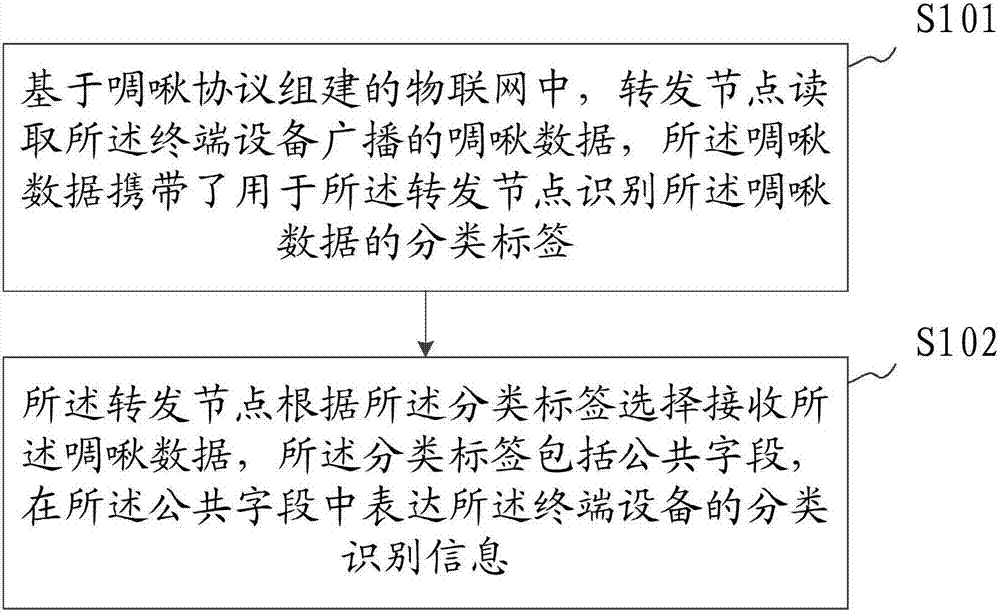Data classification method and device for terminal device
A terminal equipment and data classification technology, which is applied in the field of Internet of Things, can solve the problems that terminal equipment classification cannot be completed, and achieve the effects of minimizing overhead, reducing overhead, and simplifying addresses
- Summary
- Abstract
- Description
- Claims
- Application Information
AI Technical Summary
Problems solved by technology
Method used
Image
Examples
Embodiment 1
[0052] figure 1 A flow chart of a data classification method for a terminal device provided by Embodiment 1 of the present invention is shown. Such as figure 1 As shown, the data classification method of the terminal device specifically includes the following steps S101 to S103.
[0053] Step S101: In the Internet of Things established based on the chirp protocol, the forwarding node reads the chirp data broadcast by the terminal device, and the chirp data carries a classification label for the forwarding node to identify the chirp data; The IoT includes at least the terminal device and the forwarding node.
[0054] Among them, the chirp protocol is different from the traditional IPV6 protocol, and the terminal equipment in the Internet of Things established based on the chirp protocol does not include any error checking, routing mechanism or high-level addressing. End devices in the Internet of Things (like busy worker bees) will generate a small chirp data stream, but it ...
Embodiment 2
[0074]On the basis of Embodiment 1, in order to obtain more detailed relevant information of the terminal device after receiving the chirp data according to the classification identification information in the public field of the chirp data, after the above S102, as image 3 As shown, the method also includes:
[0075] S201: The classification label of the chirp data further includes a private field, and the private field includes at least a private payload field, and the private payload field is used to carry the state information of the terminal device, and the state information uses to express the working state of the terminal device and / or the monitoring data value of the terminal device.
[0076] Wherein, the private field is located after the public field, refer to Figure 2-B , 5, 6, and 7 represent the fifth byte, the sixth byte, and the seventh byte, respectively; the category label private field can be represented by a 3-byte category combination, where the second b...
Embodiment 3
[0081] On the basis of the first embodiment, as the third embodiment of the present invention, in order to systematically classify the chirp data more effectively, Figure 4 A flow chart of a data classification method for a terminal device provided by Embodiment 3 of the present invention is shown. Before S102 in Embodiment 1, as Figure 4 As shown, the data classification method of the terminal device specifically further includes the following steps S301 to S303.
[0082] Step S301: Count the types of terminal devices newly added to the Internet of Things, and obtain the number of types of terminal devices currently added to the Internet of Things based on the types of original terminal devices and the types of the newly added terminal devices.
[0083] For the convenience of expression, the definition is as follows: the old Internet of Things refers to the Internet of Things without new terminal devices, and the terminal devices in the old Internet of Things are called or...
PUM
 Login to View More
Login to View More Abstract
Description
Claims
Application Information
 Login to View More
Login to View More - R&D
- Intellectual Property
- Life Sciences
- Materials
- Tech Scout
- Unparalleled Data Quality
- Higher Quality Content
- 60% Fewer Hallucinations
Browse by: Latest US Patents, China's latest patents, Technical Efficacy Thesaurus, Application Domain, Technology Topic, Popular Technical Reports.
© 2025 PatSnap. All rights reserved.Legal|Privacy policy|Modern Slavery Act Transparency Statement|Sitemap|About US| Contact US: help@patsnap.com



